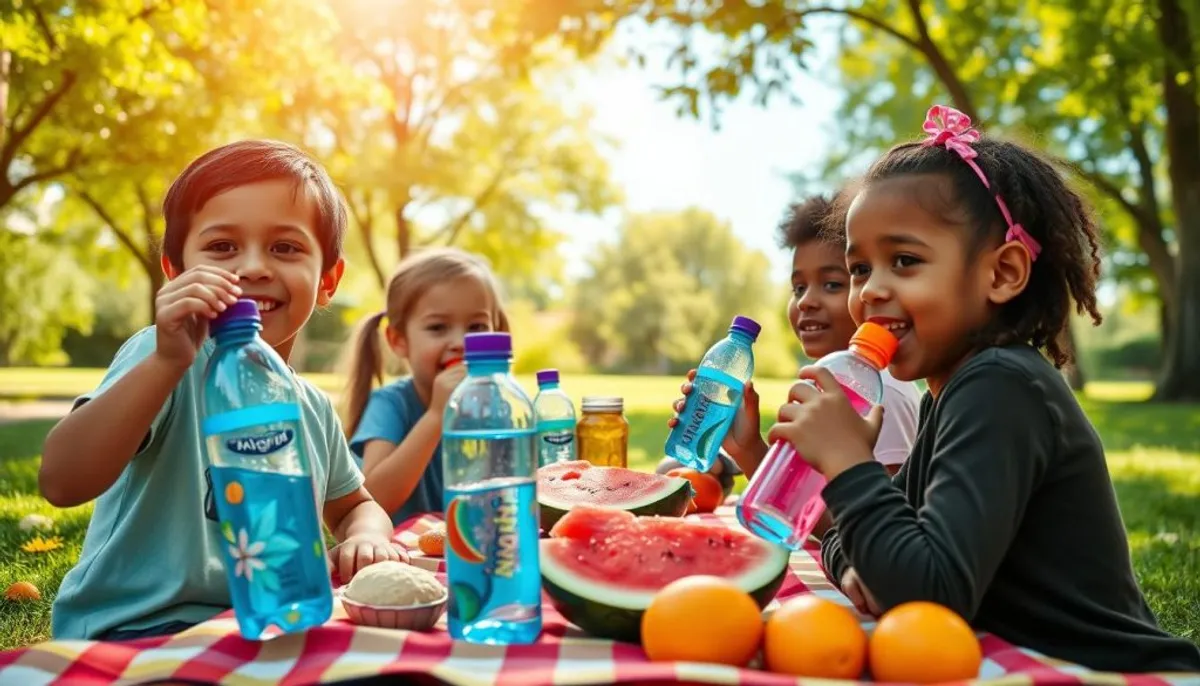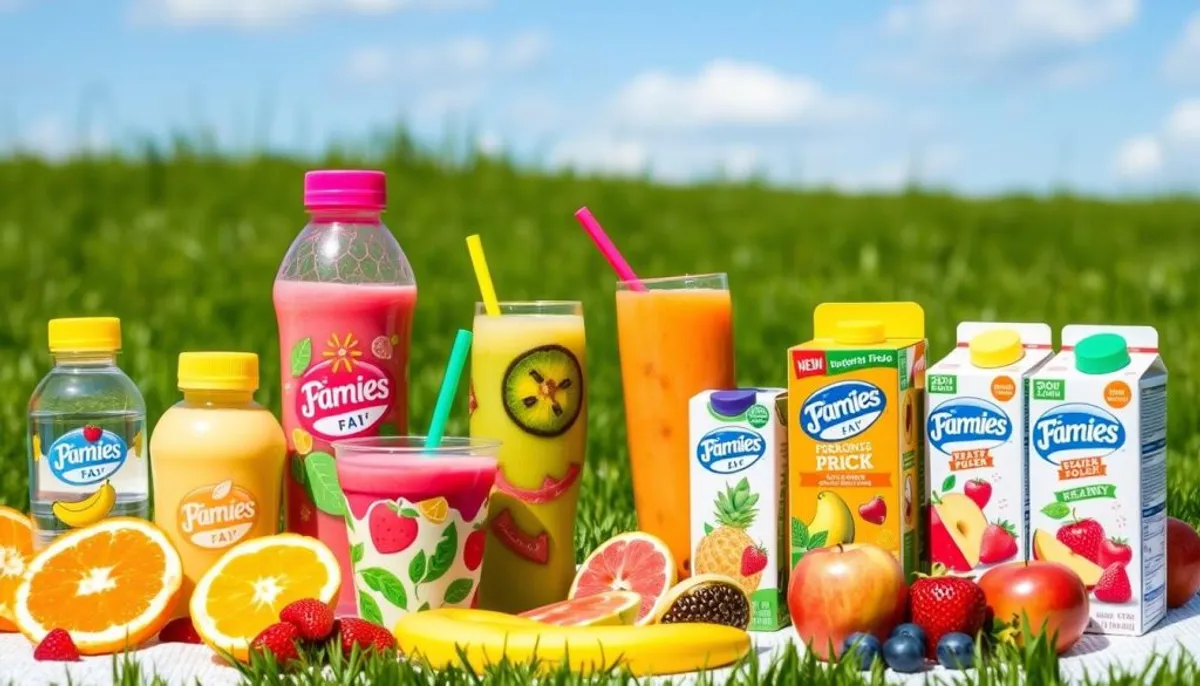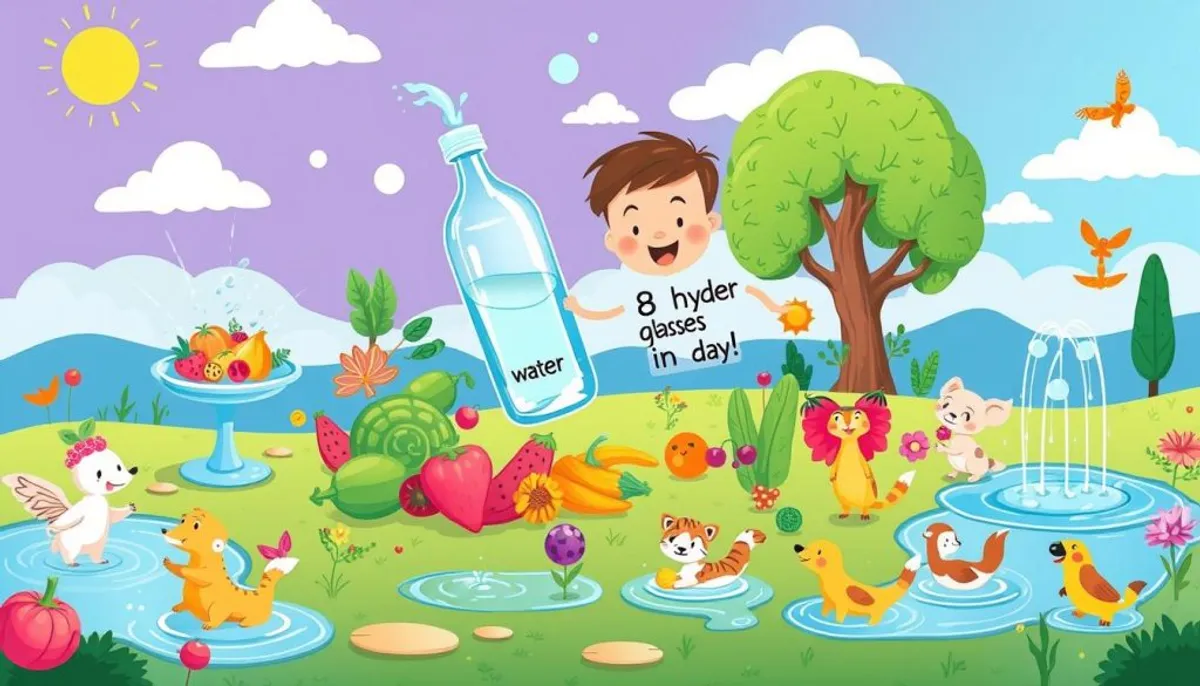Kids hydration is a paramount concern for parents. Children’s bodies are comprised of up to 70% water, underscoring the necessity of adequate hydration. Unlike adults, children lose more water through sweat, elevating their risk of dehydration. Thus, prioritizing hydration for children, notably during hot weather or physical activities, is imperative.
Child dehydration can manifest rapidly. Vigilance is required to detect signs such as dry mouth, cracked lips, and shifts in energy levels. To avert this, it is crucial to encourage frequent water intake and offer hydrating foods like watermelon or grapes. Proactive measures to stay ahead of thirst are essential for maintaining kids’ health and vigor.

To ensure optimal hydration for kids, adhere to age-appropriate water consumption guidelines. A child weighing 80 pounds should aim for 40 ounces of water daily. Younger children, aged 1-3, should drink 4 cups, while teenagers require 8-11 cups per day. Utilize engaging water bottles or add fruit slices to enhance the appeal of drinking water.
Key Takeaways
- Children’s bodies are 60-70% water, making hydration crucial
- Kids lose more water through sweat than adults
- Regular water breaks every 30 minutes during activities are important
- Hydrating foods can complement water intake
- Age-based water intake guidelines help ensure proper hydration
- Fun water bottles and fruit-infused water can encourage drinking
Understanding the Importance of Kids Hydration
Pediatric hydration is vital for children’s health and vitality. Water constitutes more than half of a child’s body weight, underscoring its role in bodily functions. Exploring the significance of hydration for kids and identifying dehydration symptoms is essential.
Why Hydration Matters for Children
Water is indispensable for kids’ bodily functions. It regulates body temperature, aids digestion, and supports cell function. The brain, comprising about 80% water, highlights the importance of hydration for cognitive performance. Adequate hydration is crucial for maintaining energy and focus in children.
The fluid needs of kids depend on age, size, and activity level. Below is a general hydration guide:
| Age Group | Daily Fluid Intake |
|---|---|
| 1-3 years | 4 cups (32 ounces) |
| 4-8 years | 5 cups (40 ounces) |
| 9-13 years | 7-8 cups (56-64 ounces) |
| 14-18 years | 8-11 cups (64-88 ounces) |
Signs of Dehydration in Kids
Identifying dehydration symptoms in children is critical for parents and caregivers. Common indicators include:
- Dark yellow urine
- Dry lips, tongue, or mouth
- Decreased urine output
- Fatigue or lethargy
- Dizziness or lightheadedness
In severe cases, dehydration can manifest as cold extremities, rapid breathing, confusion, and irritability. Immediate medical attention is required if these symptoms are observed.
Ensuring proper hydration is fundamental to children’s health and well-being. By grasping the significance of pediatric hydration and recognizing dehydration symptoms, parents can guarantee their children remain healthy, energetic, and prepared for the day ahead.
Recommended Daily Water Intake for Kids
Ensuring kids stay hydrated is a critical responsibility for parents. The amount of water children need varies with age, weight, and activity level. We will examine the guidelines and factors that influence hydration requirements.
Age-Based Water Intake Guidelines
The daily water intake for kids changes as they grow. A simple guideline is that children should drink the number of 8-ounce cups equal to their age. For those over 8, the minimum is 64 ounces. For infants and toddlers, the guidelines are different:
- Babies under 6 months: Breast milk or formula only
- 6-12 months: 2-3 ounces of water alongside breast milk or formula
- 1-3 years: 4 cups of fluids daily
- 4-8 years: 5 cups of fluids daily
- 9 years and older: 7-8 cups of fluids daily
Factors Affecting Hydration Needs
Children’s fluid needs are not solely based on age. Several factors influence how much water a child should drink:
| Factor | Impact on Hydration |
|---|---|
| Physical Activity | Increased sweating requires more fluid intake |
| Climate | Hot weather leads to higher fluid needs |
| Body Weight | Heavier children may need more water |
| Overall Health | Illness can increase fluid requirements |
Urine color is a good indicator of hydration status. Clear to light yellow urine indicates proper hydration. Dark yellow urine signals a need for more fluids. By understanding these guidelines and factors, parents can better manage their children’s fluid needs and promote healthy hydration habits.
Best Sources of Hydration for Kids
Ensuring kids stay hydrated is vital for their health and overall well-being. Water constitutes at least 60% of a child’s body, underscoring its critical role in hydration. We will examine the most effective hydration drinks for kids and strategies to keep them hydrated.
Water vs. Other Beverages
Water stands as the premier choice for hydrating children. It is devoid of calories and indispensable for bodily functions. Milk is also a superior option, offering hydration alongside vital nutrients. Fruit juices, though containing vitamins, are high in sugar and should be consumed in moderation. Sports drinks are beneficial during prolonged physical activities exceeding 30 minutes, yet they are not essential for everyday hydration.

Hydrating Foods to Consider
Interestingly, your body derives approximately 20% of its water from food intake. Incorporating water-rich foods into your child’s diet is a wise strategy to enhance hydration. Cucumber leads with 96% water content. Other hydrating foods include:
- Watermelon (92% water)
- Strawberries (92% water)
- Tomatoes (94% water)
- Celery (95% water)
These foods not only contribute to hydration but also offer essential nutrients. Encouraging kids to consume these hydrating snacks is an effective method to maintain their hydration levels throughout the day.
Creative Ways to Encourage Kids to Drink Water
Kids hydration is vital for their health and well-being. Given that children’s bodies are 60-70% water, it’s crucial to find engaging ways to keep them hydrated. Let’s explore some creative strategies to make drinking water more appealing and prevent child dehydration.
Fun Water Bottles and Accessories
Make hydration exciting with colorful cups and themed water bottles. Kids love novelty, so try these ideas:
- Use silly straws or character-themed sippy cups
- Get water bottles with built-in infusers for fruit-flavored water
- Try bottles with time markers to track daily intake
- Use sticker rewards for each cup of water consumed
Flavoring Water with Fruits and Herbs
Plain water can be boring for kids. Spice it up naturally:
- Infuse water with apple, melon, or strawberry slices
- Add refreshing herbs like mint or cucumber
- Make fruit ice cubes to add flavor as they melt
- Create homemade popsicles using water and fresh fruits
Remember, 70-80% of a child’s daily water intake should come from beverages. By making water more appealing, you can help ensure your kids stay properly hydrated throughout the day.
Hydration During Physical Activities
Kids require adequate hydration during sports and play. Active children need more water to maintain health and excel in physical activities. Exploring the significance of hydration in sports and methods to ensure kids stay hydrated is essential.
Importance of Hydration in Sports
Proper water intake is vital for young athletes. Even slight dehydration can impair performance. Research indicates that a mere 2% dehydration can diminish strength, speed, and endurance. Hydrated muscles function optimally, enhancing overall performance. It also aids in blood pressure regulation during exercise, reducing heart strain.
Tips for Keeping Kids Hydrated During Play
To ensure proper hydration for children during sports, follow these guidelines:
- Encourage kids to drink water before, during, and after physical activities
- Aim for 12-18 ounces of fluids before exercise
- During activity, provide 5-9 ounces every 15-20 minutes
- For an 88-pound child, offer 5 ounces of water every 20 minutes
- A 132-pound teen should drink 9 ounces every 20 minutes
For longer or intense activities, consider sports drinks with electrolytes. These replenish lost fluids and minerals. Clear or light-colored urine signifies adequate hydration. Adhering to these tips will ensure your kids remain healthy and active.
The Role of Parents in Promoting Hydration
Parents are pivotal in fostering hydration habits in children. By exemplifying and instilling healthy practices, they can guarantee their offspring’s hydration. Let’s examine some strategies to hydrate kids effectively and cultivate enduring hydration routines.
Leading by Example
Children tend to emulate their parents’ actions. In the realm of hydration, parents serve as role models. Always have a water bottle nearby and consume water frequently. This simple gesture can prompt kids to follow suit. Your actions convey the value of hydration more powerfully than words.
Establishing Drinking Routines
Consistent hydration practices are vital for ensuring kids consume adequate water throughout the day. Here are some practical tips:
- Offer water with every meal and snack
- Keep water easily accessible at home and on-the-go
- Teach kids to check their urine color as a hydration indicator
- Encourage drinking water even when not thirsty
By adopting these strategies, parents can integrate hydration seamlessly into their children’s daily lives. Proper hydration is crucial for kids’ health and well-being. Begin implementing these suggestions today to assist your children in developing lasting hydration habits.
Hydration Tips for School and On-the-Go
Ensuring kids stay hydrated during school hours and while on the move is vital for their health. We will discuss practical strategies to meet children’s fluid needs throughout the day.
Packing Healthy Hydration Options
When preparing for school or outings, consider these kid-friendly hydration choices:
- Refillable water bottles
- Fruit-infused water
- Fresh fruit slices (watermelon, oranges)
- Veggie sticks (cucumber, celery)
Keeping Drinks Cool and Accessible
To encourage kids hydration, make sure drinks stay cool and easy to reach:
- Use insulated bottles to maintain temperature
- Add ice cubes or frozen fruit to water
- Pack drinks in an insulated lunch bag
- Place water bottles in easily accessible backpack pockets
| Age Group | Daily Water Intake |
|---|---|
| 1-3 years | 4 cups |
| 4-8 years | 5 cups |
| 9-13 years | 5-6 cups |
| 14-18 years | 6-8 cups |
These guidelines are essential for meeting children’s fluid needs. Encourage regular sips throughout the day to maintain proper hydration levels. By implementing these tips, parents can ensure their kids stay hydrated and healthy, both at school and during various activities.
Understanding the Effects of Heat on Hydration
Heat significantly impacts child dehydration. As temperatures increase, children are at a greater risk of fluid loss. This underscores the importance of hydration for kids. Their bodies, with a larger surface area relative to weight, are more vulnerable to heat effects.
How Heat Affects Kids
In hot weather, children can lose fluids quickly. Thirst may not signal until they have lost 2% of their body weight through sweat. This delay necessitates proactive hydration measures by parents. Heat can lead to various issues in children, including:
- Dehydration
- Heat exhaustion
- Heat cramps
- In severe cases, heat stroke
Adjusting Hydration During Hot Weather
To combat child dehydration in hot weather, significantly increase fluid intake. The American Academy of Pediatrics advises that an 88-pound child should drink 5 ounces of water every 20 minutes during physical activity in the heat. For a 132-pound child, this increases to 9 ounces every 20 minutes.
When it comes to hydration for children in hot weather, remember these tips:
- Offer water frequently, even before signs of thirst appear
- Avoid sugary drinks with more than 8% carbohydrates
- Consider sports drinks for extended outdoor activities
- Encourage breaks in cool, shaded areas
- Watch for signs of heat exhaustion, such as excessive sweating or dizziness
By understanding how heat affects hydration and taking proactive steps, parents can help keep their children safe and healthy during hot weather.
Addressing Common Myths About Kids Hydration
Parents often grapple with understanding the hydration needs of their children. It’s crucial to debunk myths surrounding kids’ water intake and dehydration symptoms. Let’s shed light on the facts about children’s hydration requirements.
Debunking Misconceptions
Many believe that thirst is the sole indicator of when a child needs water. This notion is not entirely accurate. Children can become dehydrated before they even feel thirsty, which is more common during physical activities or in hot weather. Another misconception is that sports drinks are superior to water for hydration. For most children, water remains the best choice for their hydration needs.

Facts Every Parent Should Know
Dehydration symptoms in children can occur even in cooler weather. The presence of clear urine does not always signify proper hydration. The urine should be light yellow in color. The hydration needs of children vary based on their age, activity level, and the climate they are in. Water constitutes 75% of an infant’s body weight, underscoring its critical role in their health.
| Age Group | Daily Water Intake (cups) | % of Water from Food |
|---|---|---|
| 4-8 years | 5 | 20% |
| 9-13 years | 7-8 | 22% |
| 14-18 years | 8-11 | 22% |
It’s important to note that sugary drinks and fruit juices can lead to excessive calorie intake. They do not effectively hydrate. Prioritize water as the primary source of hydration for your children’s health and well-being.
Hydration Challenges for Picky Drinkers
Ensuring kids consume adequate water can be a daunting task, notably for those who are picky. We will examine various strategies and innovative approaches to ensure children remain hydrated.
Strategies for Getting Kids to Drink More
Encouraging kids to drink more can be a delightful endeavor. Establishing daily hydration goals and monitoring progress is a good starting point. Offer small incentives when they achieve their targets. Interactive water bottles with time markers can foster healthier drinking habits.
To make water more enticing, consider adding natural flavors. Watermelon, boasting a 90% water content, is an excellent choice. Infusing ice cubes with water can also pique their interest. For an added layer of fun, fill squirt guns with flavored water, turning hydration into a game.
Creative Solutions for Hydration Issues
When conventional methods prove ineffective, consider these innovative hydration solutions for kids:
- Offer hydrating foods like cucumbers, celery, and lettuce
- Make fruit-based popsicles or smoothies
- Use fun-shaped ice cubes or colorful straws
- Create educational games about hydration
Children’s bodies tend to heat up faster than adults, increasing their risk of dehydration. In warmer climates, it’s essential to adapt hydration strategies to prevent heat-related illnesses.
| Hydration Method | Benefits | Tips |
|---|---|---|
| Infused Water | Natural flavors, visually appealing | Use fruits, herbs, or cucumber slices |
| Hydrating Foods | Alternative to drinking, nutritious | Offer watermelon, lettuce, cucumbers |
| Fun Water Bottles | Encourages regular sipping | Choose bottles with time markers or characters |
| Hydration Games | Makes drinking water fun | Use apps or create your own challenges |
The Future of Kids Hydration
The future of hydration for children is rapidly evolving. With 54.5% of US children and adolescents facing inadequate hydration, the need for innovative solutions is pressing. The American Journal of Public Health has underscored the health risks dehydration poses to children, driving a surge in research and product development.
Innovations in Hydration Products
Smart water bottles are at the forefront of pediatric hydration technology. These devices monitor water consumption, aiding parents in ensuring their children stay hydrated. Some bottles even connect with smartphones, sending alerts to drink water. This technology is highly appealing to older children and teenagers, who have shown higher urine osmolality in recent studies.
Encouraging Lifelong Healthy Habits
Education is crucial in fostering better hydration habits among children. Initiatives like the Healthy Hydration in Schools program by Water Coolers Direct are making a significant impact. They donate water coolers and sports bottles to UK schools, aiming to combat dehydration and instill good habits early. Studies indicate that increasing daily water intake by just 8 fluid ounces can substantially reduce the risk of inadequate hydration in children.
RelatedRelated articles

